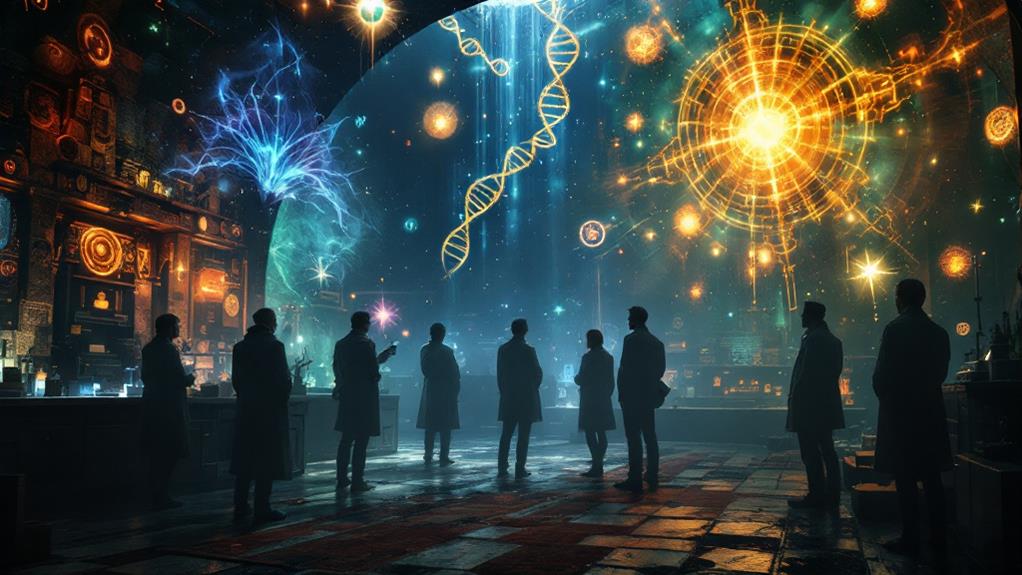Discoveries Unexplained by Science: Mysteries That Still Puzzle Experts

You've likely heard of scientific revelations that have revolutionized our understanding of the world, but some mysteries still baffle experts. The Voynich Manuscript's indecipherable text, the ancient Antikythera Mechanism's advanced technology, and the enigmatic Bloop sound from the ocean depths all challenge conventional wisdom. Dark matter, which makes up most of the universe, remains elusive, while fast radio bursts from deep space continue to perplex astronomers. Even archaeology holds its secrets, with Göbekli Tepe's intricate structures predating known civilization. These puzzles expand the horizons of human knowledge and invite further exploration into the unknown.
The Voynich Manuscript
One of history's most perplexing enigmas, the Voynich Manuscript has baffled scholars and cryptographers for centuries. This mysterious 15th-century codex, filled with bizarre illustrations and written in an unknown script, continues to defy decryption attempts. You'll find its pages adorned with strange botanical drawings, astronomical charts, and nude female figures, all accompanied by text in an unsolved language.
Numerous theories about the manuscript's origin and purpose have emerged over the years. Some believe it contains hidden messages from an ancient civilization, while others suspect it's an elaborate hoax. Despite advanced computer analysis and linguistic studies, the Voynich Manuscript's true nature remains elusive.
The text's resistance to decoding has led some experts to propose that it might be a constructed language or a complex cipher. Others suggest it could be a medieval medical text or an alchemical treatise. As you explore the mystery, you'll uncover that each proposed solution seems to raise more questions than answers. The Voynich Manuscript stands as a manifestation of the enduring power of enigmas, challenging our understanding of language, history, and human ingenuity.
Antikythera Mechanism
While the Voynich Manuscript puzzles linguists, another ancient mystery challenges our understanding of technology. The Antikythera Mechanism, uncovered in 1901 off the Greek island of Antikythera, is an ancient analog computer that's baffled scientists for over a century.
This complex device, dating back to around 100 BCE, showcases clockwork technology far ahead of its time. You'd expect to find such intricate gears and mechanisms in 18th-century Europe, not ancient Greece. The Antikythera Mechanism could predict astronomical positions, eclipses, and even the timing of the Olympic Games.
What's truly astonishing is the level of precision in its engineering. The device contains at least 30 bronze gears, with teeth as small as 1.5 millimeters, arranged in a sophisticated system. It's one of the most exceptional ancient engineering feats ever uncovered.
Despite extensive research, many questions remain unanswered. Who created this masterpiece? How did they acquire such advanced knowledge? Were there other similar devices? The Antikythera Mechanism continues to challenge our perceptions of ancient technological capabilities, reminding us that history still holds many secrets.
Bloop Sound

From the depths of the ocean comes another perplexing mystery: the Bloop. This enigmatic sound, captured by underwater microphones in 1997, has puzzled scientists for years. It's one of the most powerful deep ocean noises ever recorded, far louder than typical marine sounds.
You might wonder what could produce such an intense noise. Initially, researchers thought it might be from a massive unknown sea creature. However, further analysis suggested it was likely an icequake—the sound of ice breaking off from Antarctica. But this explanation hasn't fully satisfied all experts.
The Bloop is just one of several anomalous audio signals detected in the ocean. These unexplained sounds challenge our understanding of marine acoustics and undersea phenomena. They remind us how much we still don't know about the vast, dark expanses beneath the waves.
As technology advances, you might expect clearer answers about these mysterious noises. Yet the ocean continues to guard its secrets, leaving the Bloop and similar sounds as tantalizing puzzles for scientists and curious minds alike.
Dark Matter
Billions of stars twinkle in the night sky, but they're just a fraction of what's out there. Scientists have uncovered that visible matter accounts for only about 5% of the universe. The rest? That's where dark matter comes in. It's an invisible substance that doesn't emit, absorb, or reflect light, yet it exerts a gravitational pull on everything around it.
You can't see dark matter directly, but its effects are observable. Here's how scientists detect it:
- Galaxy rotation: Stars on the outer edges of galaxies move faster than they should, indicating extra mass.
- Gravitational lensing: Light bends around massive objects, revealing dark matter's presence.
- Cosmic microwave background: The universe's earliest light shows dark matter's influence on structure formation.
Dark matter's composition remains a mystery. It's not made of the same particles as ordinary matter, and it's not black holes or other known objects. Despite decades of research, we still don't know what it is. This enigma continues to challenge our understanding of the universe, pushing the boundaries of physics and astronomy.
Fast Radio Bursts

Imagine hearing a radio burst so powerful it outshines entire galaxies, yet it's gone in the blink of an eye. These mysterious signals, known as Fast Radio Bursts (FRBs), have baffled astronomers since their detection in 2007. They're intense pulses of radio waves lasting mere milliseconds, originating from deep space.
Despite their brevity, FRBs pack an enormous amount of energy, equivalent to the sun's output over decades. Scientists have detected hundreds of these bursts, but their exact origins remain unknown. Some occur just once, while others repeat. Theories range from exploding stars to alien technology, but none fully explain the phenomenon.
The potential implications of FRBs are vast. They could serve as cosmic rulers, helping measure the universe's expansion. Alternative theories suggest they might be signatures of advanced civilizations or exotic physics we've yet to comprehend. As researchers develop more sensitive instruments and techniques, they're inching closer to unraveling this cosmic enigma. The solution to the FRB mystery could revolutionize our understanding of the universe and our place within it.
Göbekli Tepe
A 12,000-year-old archaeological site in Turkey has turned our understanding of early human civilization on its head. Göbekli Tepe, a series of ancient temple complexes, predates agriculture and settled communities by thousands of years. This finding challenges the long-held belief that religion and complex societies emerged only after humans learned to farm.
The site's enigmatic stone structures feature intricate carvings of animals and abstract symbols, hinting at a sophisticated culture that existed during the Stone Age. Archaeologists are baffled by several aspects of Göbekli Tepe:
- How did hunter-gatherers organize and construct such massive monuments?
- What was the purpose of these elaborate structures?
- Why was the site deliberately buried around 8,000 BCE?
You'll find no evidence of permanent settlements nearby, suggesting that Göbekli Tepe was a pilgrimage site for nomadic groups. The level of craftsmanship and engineering required to build these structures implies a degree of social organization previously thought impossible for hunter-gatherers. As excavations continue, Göbekli Tepe remains a chronicle to the ingenuity of our ancestors and a reminder that there's still much to learn about human history.



